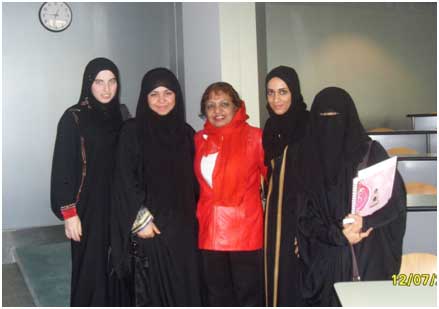Highlights of a trip to the UAE and India
Sultana N. Nahar
I was invited to the international conference on Current Developments in Atomic, Molecular, Optical and Nano Physics with Applications (CDAMOP) held at Delhi University in India in December 2011. I took the opportunity to visit the United Arab Emirates University (UAEU) and the Aligarh Muslim University (AMU) in India before attending CDAMOP. I have been connected to UAEU for a few years since the female science students interviewed me for a project presentation on a modern Muslim female scientist to the general university audience.
I was treated with a very warm welcome at UAEU. Physics Chair Professor Maamar Benkraouda spent most of Thursday with me. He kept my wish for a combined audience from the male and the female campuses at the same time. Although the male and female campuses are separated by a wall and both students sit in separate classes, they share the same facilities of laboratories and libraries but at a different time. My seminar notice on applications of atomic physics to astronomy and biomedicine was posted all over the university and the audience came from Physics, Math, Medical school and English. I visited the nanoscience lab before lunch. Maamar mentioned the importance of research at UAEU and spoke of opportunities given to students to participate in research.
UAEU also offers the Ph.D. degree in physics. However, due to the teaching load, research is slow. UAEU would welcome hosting a physics conference since UAEU has the facilities for it. They would be very much interested in the networking and collaboration possibilities of a conference sponsored by the APS.
Before the seminar, I was given one hour with female students to discuss the aims and objectives of the International Society of Muslim Women in Science (ISMWS) of which I am the founder. Students were very much motivated to stay in science. Dr. Ayesha of Medical school arranged for me to make a presentation of ISMWS at a women's residency college. Most female students came without the hijab. They were as fashionable as students of any other western country. However, they did not let me take any picture without the hijab. In school, they commonly wear a black burqa. A number of them became ISMWS members. Dr. Kimberly Conners, an American English professor at UAEU and who speaks Arabic very well, told me the difficulties Arab women very often face in intellectual profession due to unsupportive husbands and fathers. The Physics Department has only one female at the teaching level, Sadiqa from Jordan, She is a lab instructor and is pursuing her Ph.D. in physics. Sadiqa, a very lively person, was given the responsibility of taking me around in Al Ain.

Meeting with female physics students at United Arab Emirates University
I donated a number of astronomy and physics books to the main library. Since I was there at the 40th National Day for the union of Emirates to UAEU, my presence and giving our own textbook "Atomic Astrophysics and Spectroscopy" (Cambridge University press) were noted to be included in their anniversary newsletter.
I was also introduced to the delegates from Sultan Qaboos University of Oman on collaborative visit to UAEU and joined them for lunch. Now I am in contact with the Dean Professor Saif Al-Bahry and Physics Chair Professor Sheik Rahman regarding APS membership and ISMWS.
From UAEU, I went to Aligarh Muslim University (AMU) in Aligarh, India. AMU was founded to encourage Muslims, who were far behind the Hindus and other groups in India under British rule, in higher education. AMU rose to excellence and led India in spectroscopy. However, for over the last 40 years, it has been rated much lower compared to top Indian universities. Here I gave two physics seminars in two days and one speech on ISMWS. I was asked by Physics Chair Professor Wasi Haider to teach at AMU through video conferencing. There are lots of enthusiastic students and some teachers are very dedicated in research. They will really appreciate a connection with APS. For encouragement in physics, I initiated four Physics awards, two for teaching and two for students during my visit.

Presentation of award to the best female physics student at Aligarh Muslim University in India
To introduce an undergraduate astronomy course, for which students are very much interested but not available at AMU, I contributed books to the Physics library. I also spoke on behalf of AMU at the US-India universities meeting held in Delhi where I was for the CDAMOP conference. The Indian government is aiming to build a large number of universities, 40 of which could be equivalent to the top US universities. The meeting was on the US-India collaboration on this subject.
Attending the CDAMOP conference were a large number of international scientists. Many high quality research results were presented. CDMAOP was also very well organized under the supervision of the convener Professor Man Mohan of Delhi University. I was surprised that most of the Indian participants were not APS members and unaware of some APS facilities. They would like to be part of APS very much. However, the high APS membership fee is the main obstacle. There was a big round of applause in the concluding session when I commented that I would propose at the FIP EC meeting a discount membership fee for the developing and Arab countries.
Dr. Sultana N. Nahar is in the Department of Astronomy, The Ohio State University in Columbus, Ohio and a newly elected member of the FIP Executive Committee.
Disclaimer—The articles and opinion pieces found in this issue of the APS Forum on International Physics Newsletter are not peer refereed and represent solely the views of the authors and not necessarily the views of the APS.
